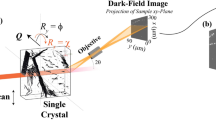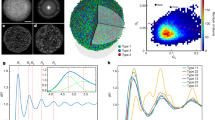Abstract
Under favourable circumstances, high resolution axial bright-field transmission electron micrographs can provide information on the medium-range structure of oxide glasses and amorphous semiconductors1. Specifically, the presence in an image of localised patterns of fringes, with the fringe spacing related by Bragg's law to the first diffraction peak, provides evidence of correlations in atomic positions over distances in the range 8–15Å. ‘Amorphous lattice fringes’ with these characteristics have been studied in many amorphous solids but hitherto have not been reported in glassy metals, although several attempts have been described previously2–4. We present here what we believe to be the first high resolution axial, bright-field micrographs with lattice resolution of an amorphous metal, taken with the Cambridge University 600 kV high resolution electron microscope (HREM)5. The image features obtained indicate that it is now possible to observe directly the microstructure of amorphous metals, thereby emphasising the potential of high resolution microscopy as a tool for furthering the understanding of the structure of amorphous metallic glasses.
This is a preview of subscription content, access via your institution
Access options
Subscribe to this journal
Receive 51 print issues and online access
$199.00 per year
only $3.90 per issue
Buy this article
- Purchase on Springer Link
- Instant access to full article PDF
Prices may be subject to local taxes which are calculated during checkout
Similar content being viewed by others
References
Krivanek, O. L., Gaskell, P. H. & Howie, A. Nature 262, 454–457 (1976).
Lewis, B. G. & Davies, H. A. Mater. Sci. Engng. 23, 179–182 (1976).
Vitek, J.M., Van der Sande, J.B. & Grant, N.J. Acta metall. 23, 163–176 (1975).
Doi, M., Kosaki, H. & Imura, T. in Rapidly Quenched Metals III (ed. Cantor, B.) Vol. 2, 372–377 (Metals Society, London, 1978).
Cosslett, V.E. et al. Nature 281, 49–51 (1979).
Thon, F. Z. Naturforsch. 20 a, 154–155 (1965).
Stobbs, W.M. & Smith, D.J. Nature 281, 54–55 (1979).
Mistry, A. B. thesis, Univ. Cambridge (1978).
Kamminga, W. Optik 45, 39–54 (1976).
Fukunaga, T., Misawa, M., Fukamichi, K. & Suzuki, K. in Rapidly Quenched Metals III (ed. Cantor, B.) Vol. 2, 325–329 (Metals Society, London, 1978).
Temkin, R. J., Paul, W. & Connell, G. A. N. Adv. Phys. 22, 581–641 (1973).
Alben, R., Cargill, G. S. & Wenzel, J. Phys. Rev. B 13, 835–842 (1976).
Cochran, W. Phys. Rev. B 8, 623–629 (1973).
Krivanek, O. L. thesis, Univ. Cambridge (1975).
Author information
Authors and Affiliations
Rights and permissions
About this article
Cite this article
Gaskell, P., Smith, D., Catto, C. et al. Direct observation of the structure of a metallic alloy glass. Nature 281, 465–467 (1979). https://doi.org/10.1038/281465a0
Received:
Accepted:
Issue Date:
DOI: https://doi.org/10.1038/281465a0
This article is cited by
-
Atomic motifs govern the decoration of grain boundaries by interstitial solutes
Nature Communications (2023)
-
Computer simulation studies of Ar clusters
Bulletin of Materials Science (1999)
-
Local structure in amorphous alloys from symmetry properties
Hyperfine Interactions (1986)
-
Particle motion in glasses
Proceedings / Indian Academy of Sciences (1985)
-
Glass transition. A new approach based on cluster model of glasses
Proceedings / Indian Academy of Sciences (1984)
Comments
By submitting a comment you agree to abide by our Terms and Community Guidelines. If you find something abusive or that does not comply with our terms or guidelines please flag it as inappropriate.



